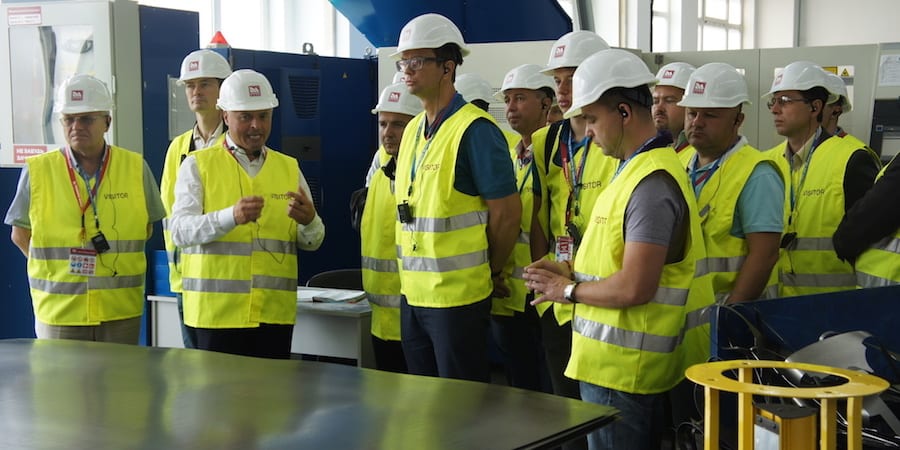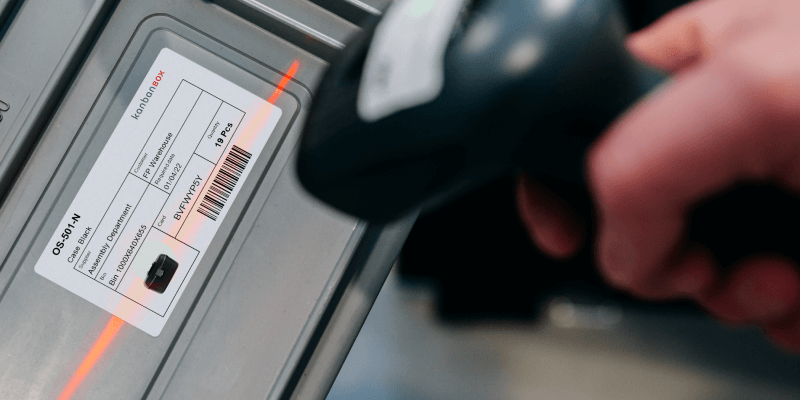
How a Ukrainian company modernized itself using lean
INTERVIEW – In this Q&A, the CEO of a Ukrainian provider of equipment for stores shares how lean thinking has helped his company modernize its processes and engage its people.
Interviewee: Petro Pylypyuk, CEO, Modern-Expo Group
Interview by: Serhii Komberianov, President, Lean Institute Ukraine
Serhii Komberianov: Can you briefly introduce Modern-Expo to Planet Lean readers?
Petro Pylypyuk: Modern-Expo was founded 20 years ago in the city of Lutsk, in western Ukraine. We have grown from a small business into a multinational holding company specialized in complete retail solutions and operating across Central and Eastern Europe. We have three factories – two in Ukraine, one in Belarus – supplying equipment to more than 60 countries worldwide.
SK: You have applied lean since 2008. How did you get started and how did the journey evolve?
PP: Back in 2008, we learned that some of our competitors were achieving great results thanks to lean. We naturally developed an interest in it and started looking for the literature. Our first step was the introduction of one of lean’s most basic tools – 5S.
Even though at the time we stopped at the first three ‘S’s, we managed to bring order to our shopfloor. What we didn’t get was the economic breakthrough we were hoping for. Yet, the signs that this was possible were everywhere, so we continued to explore lean. In 2014, as part of a conference in Poland, we visited a FIAT plant in Tychy. I remember being astonished and returning home energized and determined to make Modern-Expo processes operate in the same powerful and coordinated manner.
At the same time, we realized there is more to lean than just tools and started to look at the bigger picture. We analyzed the work step by step, identified waste and inefficiencies, and assessed the losses they generated. Before too long, it became clear that we’d have to find ways to perform our work in less space and more efficiently.
So, we introduced flow, organizing production in cells. That was the moment when a radical transformation of our plant took place: we changed the distribution of machinery in our workshops, with the idea of implementing individual product streams (prior to this, all our laser machines were located in the same place). This made equipment maintenance more difficult because specialists had to move around different workshops all the time, but it sped up production. Our production time dropped from one week to two days.
The next step in our plant's transformation was the elimination of inventory of finished products, as they too represented waste. Instead, we switched to make-to-order production. This allowed us to reduce the time our products stayed at the warehouse to three days. Accordingly, our warehouse shrunk and we stopped the construction of an additional building. Not only do we not plan to ever build another warehouse; we also rent out the space we freed up. Thanks to lean, we are working more efficiently than ever before, using less space and machines. Employees who were no longer needed in the warehouse were re-assigned to other activities.
SK: Did you meet resistance from people? How did you involve them and ensure they would start to think lean?
PP: We did face resistance at first. You always do when you ask people to get out of their comfort zone. However, to successfully introduce lean thinking in a firm you need both senior management support and people buy-in. My confidence in the methodology led to a positive response from our director of production, Igor Mordas. Together, we started doing simple daily changes, involving more and more people in the process and communicating regularly with the medium management. We even asked senior managers to study lean thinking and we tested them on it, because we want everyone to speak the same language.
It was clear that the approach to engage the front line had to be different – nobody would produce good results without understanding what benefits they would gain from the transformation. So, we explained to people that their work would become much easier. We also thought there would be no reason to shy away from making clear there is a connection between a better financial performance for the business and people’s salaries. We established a system of bonuses for lean activities our people perform, but also realized the importance of the emotional aspect of people changing their work: seeing your colleagues embracing a new way of working encourages you to do the same. I remember one operator who strongly opposed the 5S methodology and only started to use it when he saw everyone else around him doing it. Today, he is of the most prominent supporters of the 5S technique!
Change requires motivation, and at Modern-Expo this was best created using a mix of monetary incentives and peer pressure.
SK: What is your approach to people’s professional development?
PP: I believe the educational system in Ukraine is very lacking, both in high schools and in universities. Vocational training is all but non-existent. Because of this, people tend to hear about lean for the first time when they join the company. We want them to start from scratch with their education and, with this in mind, we have created a training department that aims to not only teach the lean basics but also develop leadership skills. Next year, we are launching a new Modern Lean Production program, consisting of a set of 10 one-day modules designed for both production and office personnel.
Another challenge we face in our country is the fact that it is becoming increasingly hard to find and retain talent, because Ukrainians tend to leave to seek fortune in Europe or Russia. This makes educating our own people to become specialists even more critical.
SK: Can you give me a few examples of process improvements?
PP: Our efforts to optimize processes created a lot of positive results. Our workshops have become autonomous in producing an entire product ready for delivery and to control its quality right where production takes place. Before the change, our quality control department had around 45 people; but now, when the responsibility lies within the workshops, the number does not exceed 10 (again, it’s important to stress that nobody was laid off). The role of our quality professionals has changed slightly: it is no longer to check the product is of a high standard from the beginning, but to intervene and help people in case any serious problems occur. What did we get out of this? Our need for specialists, such as controllers and packers, decreased rapidly (we could have them focus on other value-adding activities), our lead-time decreased and our quality went up.
Another example is the movement of our products. Upon mapping the value streams, we realized that one of our products was travelling a very long distance across the workshop during the manufacturing process. We re-arranged the value stream so that all tasks could be undergoing in a single session and in the same place, which resulted in the distance decreasing from 5 kilometers to 300 meters.

SK: What are your working on at the moment?
PP: We are currently encouraging the office employees to get out of their comfort zone. When we introduced lean in production, we saw fantastic results. The same happened when we brought it to logistics, which made our efficiency grow by 30% in the first half of 2017. Now we have a new challenge: making our offices lean. These are the people who generate ideas and work with clients on a regular basis – the impact on Modern-Expo can be huge! One of the difficulties we are experiencing is ensuring that office staff understands that their processes are intertwined with those carried out in the rest of the business.
SK: What are the biggest challenges Modern-Expo faces as a retail business?
PP: Considering the growth of e-commerce, our industry faces quite the challenge. It is no longer just about offering products online – customers now expect more in the way of tailored services. People don’t want to wait in line anymore, they don’t want to waste any time finding what they are looking after, they don’t even want to have to go to the supermarket anymore. Retail giants like Amazon have understood this, and are using modern technology like robotics, computer vision and sensors to enhance the customer experience. We at Modern-Expo Group also see this as the path to the future, and are working hard to find the best way to integrate technological solutions into our equipment.
SK: As CEO, what is your role in the lean transformation?
PP: We all know how important the role of leadership is in ensuring the success of a lean turnaround. It is my responsibility to help people see why lean has the potential to change their lives.
It’s been a journey for me, too, of course. I have been aware of lean thinking for a long time, but it wasn’t until four years ago that I truly understood its potential. My epiphany took place when a group of German consultants, who had been invited to assess our organization, told us that there wasn’t much that was modern about Modern-Expo: we thought we were doing pretty well, but they told us we were like a company in 1980s. That was quite the eye-opener! We may have been using state-of-the-art technology, but our processes and organizational structure were outdated.
The very next day, I started reading Toyota Production System: Beyong Large-Scale Production by Taiichi Ohno. I finally realized we had a huge problem that we weren’t seeing: becoming more efficient and transforming ourselves was a necessity in the current market conditions (many Ukrainian companies still haven’t realized this need for change). I saw something in lean that could really help, and started to spend every waking hour at the company, trying to adapt the TPS ideas to our circumstances. (Of course, many were telling me that Ukraine is not Japan – I am sure you can relate.) I knew I had to understand lean myself before others could.
They say lean is like a religion. If that’s true, then the CEO is like a prophet: an early believer who spreads the good word.
THE INTERVIEWEE

Read more


FEATURE – Construction is rife with waste, and yet lean is not widely adopted in the industry. The authors highlight how lean could benefit the sector, emphasizing the importance of developing problem-solving capabilities.


CASE STUDY – Faced with safety and quality issues, this Brazilian manufacturing plant installed a dojo, and the results are very promising.


FEATURE – The benefits of establishing a lean operating system will support the growth and success of a business in the long term, says Karen Gaudet looking back at her experience at Starbucks.


FEATURE – This article explores the benefits of an electronic kanban and explains how it enables a truly lean supply chain.

